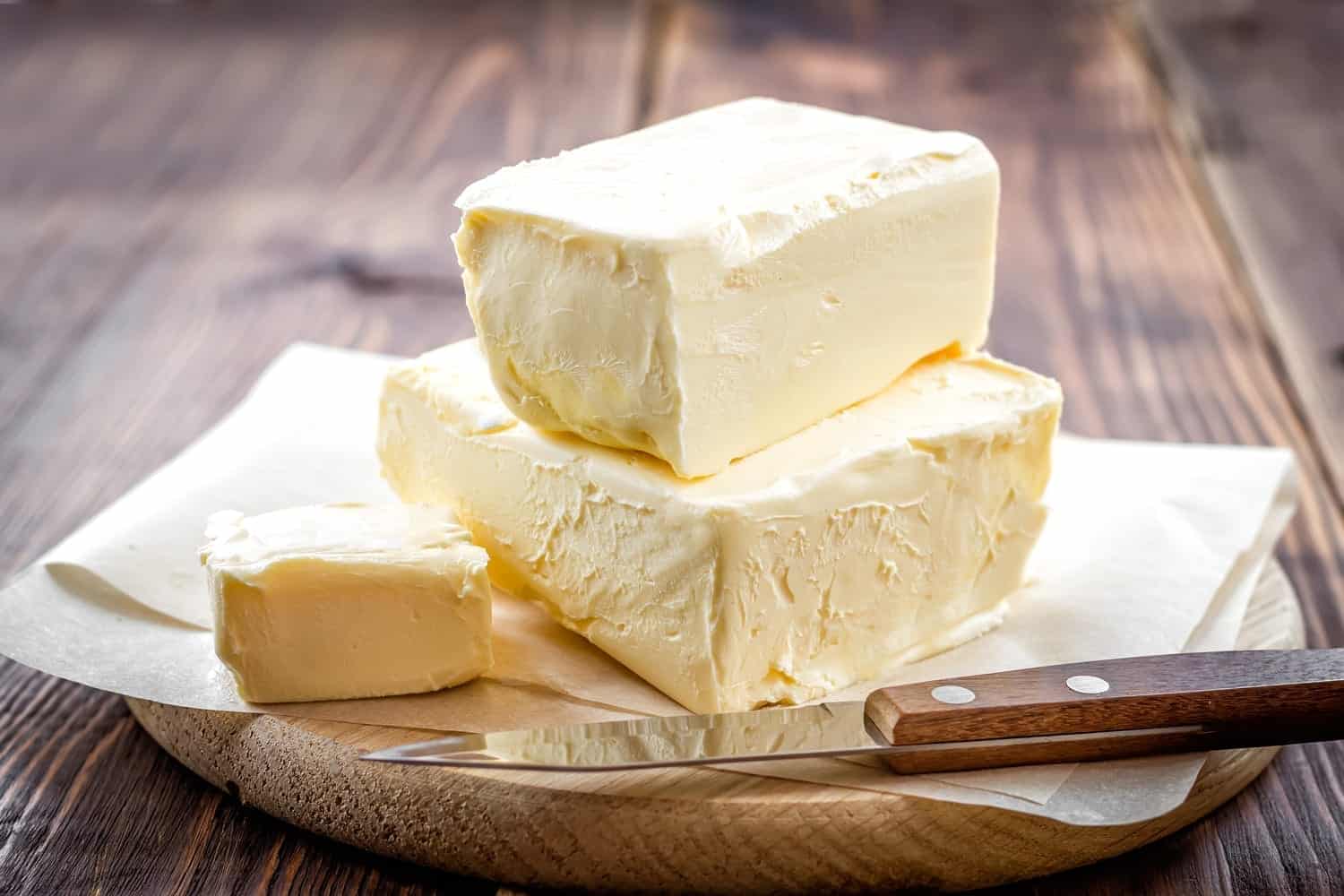For centuries, families raised their own cows to provide natural dairy foods for their tables. They drank unpasteurised, non-homogenised milk, whipped the cream, and churned the butter. These foods provided excellent nutrition, satisfied the appetite and tasted great. In more recent time, however, man-made products, such as butter substitutes, margarines and spreads have replaced some of the good fats that were given to mankind to promote health and prolong life. Without doubt, the original, natural butter is better. It is healthier, tastier, and provides a multitude of nutrients to protect against diseases.
Dr. Weston Price, who extensively studied ancestral diets, found that butter was a staple for many vibrantly-healthy populations.1. Then in 1912, Professor Paul Sabatier shared the Nobel Prize in Chemistry for developing a process, using nickel oxide as a catalyst, to solidify liquid oils. The reaction, called hydrogenation, converts vegetable oils into margarine which is now used in most processed foods, including breads, biscuits, fast food, cakes and most fried foods. For decades, these sham-fats have been promoted as “healthy alternatives” to butter, whereas in actual fact, they promote disease and shorten life. Vegetable oils are refined, emulsified and subjected to high temperatures, then reacted with the nickel. Dyes and flavours are added to make the product resemble butter.2 This process produces trans-fatty acids which penetrate cell membranes, disrupt white cells, aggregate red cells and increase the risk of many diseases.
In the 1940’s, researchers reported a strong correlation between cancer and the consumption of fat. While hydrogenated fats were the only fats on which these studies were based, the blame was placed on saturated fat.3. Since then, fears associated with butter consumption have been generated by the fact that butter contains saturated fat, a health promoting, yet falsely maligned nutrient. The latest fat research clearly shows that it is harmful to consume damaged fats, such as hydrogenated oils or those produced using high temperatures. Saturated fats are stable. They support immune function4 and help maintain cell integrity,5. Hydrogenated trans-fats block the body’s ability to use essential fatty acids, such as DHA. This can lead to increased blood cholesterol and immune system dysfunction.6. Consumption has also been associated with coronary heart disease, cancer, diabetes, obesity, Alzheimer’s disease, liver dysfunction, decreased visual acuity, infertility and problems with bones and tendons.7,8,9,10 In 2002 the National Academy of Sciences attempted to set a safe intake level for trans-fatty acids and concluded, “the only safe intake of trans-fat is zero.”11.
Fatty acids are classified according to their degree of saturation and by their length. Butter consists of both short and medium chain fatty acids, being shorter in length than most of the fatty acids found in other fats and oils. Their length allows them to be directly absorbed from the intestines for energy.12,13 Longer chain fatty acids take more energy and time to process.11 For this reason shorter fatty acids are less likely to cause weight gain than vegetable oils.12 Furthermore, because butter is rich in nutrients and saturated fats, it offers a feeling of satisfaction, thus reducing cravings and binging. The short and medium chain fatty acids also contribute to the health of the immune system14 and provide antimicrobial properties, which protect the gut from viruses, yeasts, and pathogenic bacteria.14,15 Increased butter consumption has been renowned for improving digestion and reversing conditions, from dyspeptic stomach through to itchy anus.
Butter is rich in vitamins A, D, E and K. It also provides all the cofactors needed to optimize absorption of these nutrients. In fact, vitamin A is more easily absorbed and utilized from butter than from any other food.15 .Vitamins A and D are essential in the absorption of calcium, necessary for strong bones and teeth. Vitamin A is particularly important for protein utilization.5 Coronary heart disease risk is lower among those who consume more vitamin E than those who take in less.16 Butterfat also contains trace minerals, including manganese, zinc, chromium and iodine.15 Butter is also rich in conjugated linoleic acid, or CLA. Women with the highest levels of CLA in their diet have a 60% lower risk of breast cancer than those with the lowest levels.17 CLA has also been found to support the immune system and encourage muscle building, while resisting weight gain.18 Fat-phobia has led to a reduced intake of this valuable nutrient, since it is only found in foods such as whole milk, beef, lamb, and butter. Research confirms that naturally raised grass-fed animals have as much as 500% more CLA in their milk than those fed conventional grain-based diets.19
The only natural source of butyric acid is in cow milk-fat. Butter and clarified butter (ghee), offer high amounts of this beneficial fatty acid. Butyric acid, or butyrate, is the primary fuel for the colon walls, and supports the function and integrity of the gastrointestinal tract.20 It is also used extensively by the brain to produce GABA (gamma-amino butyric acid), which is the brain’s natural calming agent that helps turn off stress reactions.21 The by-product of butter is water. Accordingly, a reasonable daily intake of butter will assist in proper hydration of the bowel and produce healthy, regular bowel movements. Butter also provides sustained energy for many hours. The main by-product of carbohydrate is glucose which can be used for quick energy or stored as fat. Carbohydrate metabolism tends to dehydrate, creating a need to drink more water.
Butter has properties that protect the heart, unlike margarine and other fabricated fats that are its real threat. Stearic acid, found in beef fat and butter, is actually a preferred food for the heart.22,23 This is why the fat around the heart is highly saturated. A Medical Research Council survey showed that men eating butter ran half the risk of developing heart disease as those using margarine.24 A study in India, published in the 1976 issue of the American Journal of Clinical Nutrition, compared two populations in India (northern and southern), where the notable difference in the diet was the type of fat consumed. Those in the north consumed meat and ghee as their main sources of protein and fat. The southern population used margarine, did not eat meat, yet had a heart disease rate 15 times greater than the northern group despite the fact they had lower cholesterol levels.25 A follow-up study was completed 20 years later and reported similar statistics.26 Without doubt, the substitution of natural saturated fats with processed vegetable oils has proved to be a major health disaster!
Cholesterol is found in all body tissues and comprises an integral part of cell membranes. It is necessary for repair and maintenance, hormone production, brain function, immune function, eye development, transportation of antioxidants and elimination of fat soluble toxins. Cholesterol is also necessary in the metabolism of serotonin, the “feel-good” brain chemical,27 which explains why low cholesterol levels have been linked to poor moods, depression and aggressive behaviour. The body tries to maintain a balance between the amount of cholesterol consumed and the amount manufactured by the liver. If too little is consumed through food, the liver will produce more. If adequate amounts are eaten, the liver produces less. This is why even drastic decreases in dietary cholesterol intake often produce only small drops in blood cholesterol.28 Also, lecithin in butter assists in the proper assimilation and metabolism of cholesterol.15
Butter and cream contain very little lactose or casein, the two substances that cause dairy intolerance in some people. Accordingly, these foods may be tolerated by those who are lactose intolerant. Those with extreme intolerance for milk protein (casein) can often take butter in the form of ghee from which the milk solids have been removed.29
Butter is indeed better and can be eaten with confidence. Organic butters are available in most supermarkets. I recommend the original unprocessed solid butter. Spread it over vegetables, add it to cooking and mash it with potatoes. However you use it, enjoy this God-given delicacy while you reap a multitude of health benefits.
References
1 Price, Weston, DDS “Nutrition and Physical Degeneration” 1945, Price Pottenger Nutrition Foundation, Inc., La Mesa, California.
2 Kabara, J J, “The Pharmacological Effects of Lipids”, The American Oil Chemists’ Society, Champaign, IL, 1978, 1-14; Cohen, L A, et al, J Natl Cancer Inst ,1986, 77:43
3 Enig, Mary G, PhD, Nutr Quarterly, 1993, 17 :(4):79-95
4Kabara, J J, The Pharmacological Effects of Lipids, The American Oil Chemists Society, Champaign, IL, 1978, 1-14; Cohen, L A, et al, J Natl Cancer Inst, 1986, 77:43
5 Enig, Mary Ph.D. and Fallon, Sally. “The Skinny on Fats.” Found at www.westonaprice.org. Published 1999. Found on Dec. 18th 2001.
6 Enig, Mary G, PhD, Trans Fatty Acids in the Food Supply: A Comprehensive Report Covering 60 Years of Research, 2nd Edition, Enig Associates, Inc, Silver Spring, MD, 1995, 148-154; Enig, Mary G, PhD, et al, J Am Coll Nutr, 1990, 9:471-86
7 Fallon, Sally. Nourishing Traditions. ProMotion Publishing. San Diego, CA. 1995.
8 Enig, Mary Dr. Health Risks from Processed Foods and Trans Fats. Interview with Richard Passwater, Ph.D. Whole Foods Magazine. Found at www.healthy.net on Nov. 18th 2001.
9 Enig, Mary G, PhD, Trans Fatty Acids in the Food Supply: A Comprehensive Report Covering 60 Years of Research, 2nd Edition, Enig Associates, Inc, Silver Spring, MD, 1995; Watkins, B A et al, Br Pouli Sci, Dec 1991, 32(5):1109-1119
10 Wikipedia. Trans Fat. Health Risks. References 38-57. Coronary Heart disease and other diseases.
11 NAS Panel: Only Safe Intake of Trans Fat is Zero” Centre for Science in the Public Interest, 7/10/02, cspinet.org
12 Fife, Bruce, M.D. “The Healing Miracles of Coconut Oil.” Healthwise, Colorado Springs, CO. 2001
13 Portillo, M P, et al, Int J Obes Relat Metab Disord, Oct 1998, 22(10):947-9; Dulloo, A G, et al, Metabolism, Feb 1995, 44(2):273-9
14 Kabara, J J, The Pharmacological Effects of Lipids, The American Oil Chemists’ Society, Champaign, IL, 1978, 1-14; Cohen, L A, et al, J Natl Cancer Inst ,1986, 77:43 Copyright © 2004 Vitamin Cottage Natural Grocers, Inc. Originally published in the Vitamin Cottage Health Hotline October 2004
15 Enig, Mary PhD and Fallon, Sally. ”The Skinny on Fats.” Found at www.westonaprice.org Published 1999. Found on January 5, 2004.
16 Rimm EB, et al. Vitamin E consumption and the risk of coronary heart disease in men, N Engl J Med 1993;328:1450-6
17 Aro, A., S. Mannisto, I. Salminen, M. L. Ovaskainen, V. Kataja, and M. Uusitupa. “Inverse Association between Dietary and Serum Conjugated Linoleic Acid and Risk of Breast Cancer in Postmenopausal Women.” Nutr Cancer 38, no. 2 (2000): 151-7.
18 Belury, M A, Nutr Rev, April 1995, 53:(4)83-89; Kelly, M L, et al, J Dairy Sci, Jun 1998, 81(6):1630-6
19 Satter, Larry. USDA ARS US Dairy Forage Resarch Center. 1950 Linden Lane. University of Wisconsin, Madison WI Found at www.mercola.com on September 11, 2003
20 Levin, Buck, PhD. R.D. 1994. Intestinal Permeability and Nutritional Support for Intestinal Integrity. Quarterly Review of Natural Medicine. Nutrition Research Review
21 Ross, Julia, MA. The Mood Cure. Viking Publishing. 2002.
22 L D Lawson and F Kummerow, “B-Oxidation of the Coenzyme A Esters of Vaccenic, Elaidic and Petroselaidic Acids by Rat Heart Mitochondria,” Lipids, 1979, 14:501-503
23 Lawson, L D and F Kummerow, Lipids, 1979, 14:501-503; Garg, M L, Lipids, Apr 1989, 24(4):334-9
24 Nutr Week, Mar 22, 1991, 21:12:2-3
25 American Journal of Clinical Nutrition, 1967, 20:462-75
26 Bihari S. Raheja of the Jaslok Hospital in Bombay. Lancet. Letter November 1987.
27 H Engelberg, “Low Serum Cholesterol and Suicide,” Lancet, March 21, 1992, 339:727-728
28 Enig, Mary, Ph.D. Know Your Fats. Bethesda Press, Silver Spring, MD. 2000
29 Fallon, Sally. Nourishing Traditions. New Trends Publishing. 2001.









